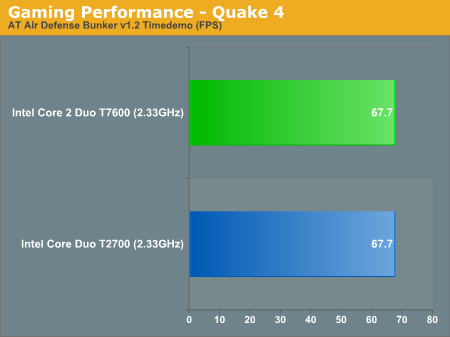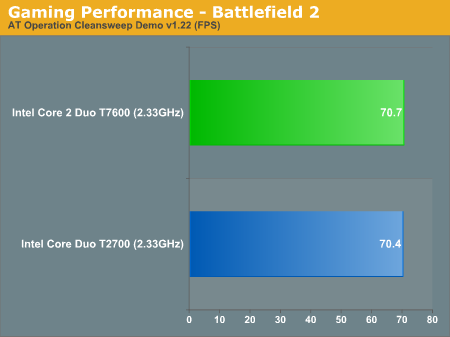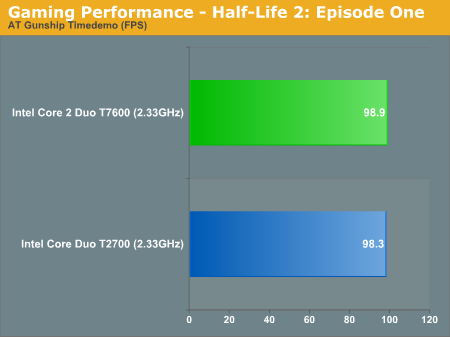Mobile CPU Wars: Core 2 Duo vs. Core Duo
by Anand Lal Shimpi on August 3, 2006 9:25 AM EST- Posted in
- CPUs
Gaming Performance using Quake 4, Battlefield 2 & Half-Life 2 Episode 1
Our gaming performance analysis starts out with Quake 4 running at 800 x 600 with Low Quality visual settings. We used version 1.2 of Quake 4 and SMP was enabled:

Despite the relatively low quality settings, there's no difference between Core Duo and Core 2 Duo in gaming performance here. Unfortunately, the fastest Merom compatible laptop we have on hand is severely constrained in gaming performance by the X1600 GPU. Desktop performance of the X1600 Pro is lower than a GeForce 6600GT in nearly every test, and a 6600GT is basically a "budget gaming" GPU these days. We will have to get a laptop with a faster GPU before we can determine exactly the real difference in gaming performance between Merom and Yonah. We'll include additional gaming results for completeness, as there may be a few CPU-limited games even with the X1600 GPU.
Let's see if the same trend exists under Battlefield 2; here we ran at 800 x 600 with default settings:

Once again there's no performance difference, and we're basically entirely GPU bound. Performance gets cut in half if we up the resolution to 1280 x 800, and we're rendering 2.13X as many pixels at the higher resolution. Obviously, if mobile gaming performance is important to you, you'll want a faster GPU.
The same trend continues under Half Life 2:











46 Comments
View All Comments
IntelUser2000 - Saturday, August 5, 2006 - link
Correct. Lots of the benchmarks show 10% advantage for Core 2 Duo over Core Duo. The only 10% advantage 4MB L2 over 2MB L2 is in a single app.
bob661 - Thursday, August 3, 2006 - link
Video makes ALL the difference in the world.monsoon - Thursday, August 3, 2006 - link
I'm in the market for a mini PC to do video trancode, and I was considering the MEROM chip to compare to YONAH......in the end, given the right graphic card ( add ATI X1400 series or higher here ) with hardware embedded transcode features, i guess the YONAH fits my bill just right.
And i get to pay 100$ or 200$ less than the same computer with a MEROM which could not offer me better on the video side...
What do you think ?
bob661 - Thursday, August 3, 2006 - link
I would get the best video you can get with the cash saved from getting the Memron.Tiamat - Thursday, August 3, 2006 - link
Whats the difference between the Intel Core Duo T2300E* and the Intel Core Duo T2300E?I see a difference in price, but not specs. The page in the article does not address the asterisk...
Anand Lal Shimpi - Thursday, August 3, 2006 - link
The asterisk means that the CPU lacks support for Intel Virtualization Technology (VT). I had the note on Page 3 but I forgot to include it on Page 2 :) Thanks for the heads up :)Take care,
Anand